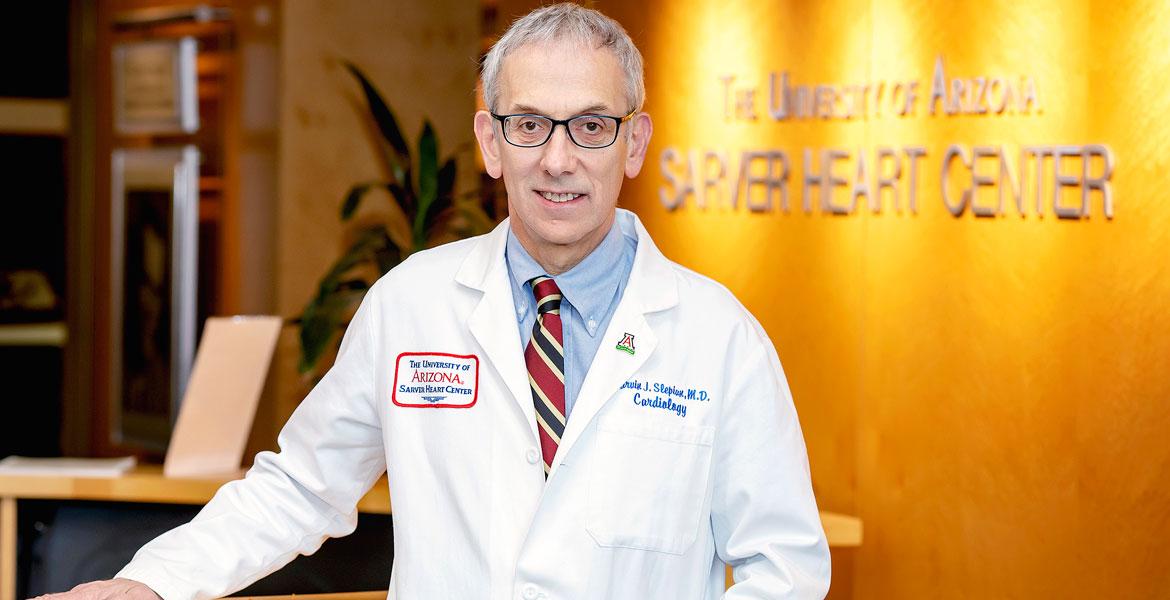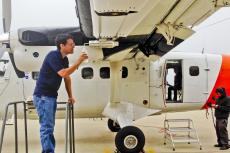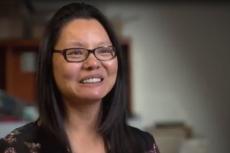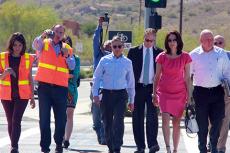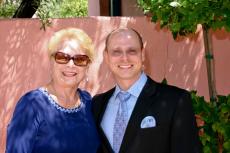2019 da Vinci Fellow: Dr. Marvin J. Slepian
Dr. Marvin Slepian’s father was also a doctor -- the old-fashioned kind in New York, who had a medical office in his house, carried around a black bag and made house calls. Young Slepian’s favorite part of it? The in-home laboratory, where he conducted some of his very first experiments as a kid, learning to build devices, test the limits of creativity and even blow a few things up.
“The demonstration that doing things in the lab can actually make a difference, leading to projects and solutions that can impact many people, was transformative in my own life,” said Slepian, associate department head for biomedical engineering clinical and industrial affairs, cardiologist at the Sarver Heart Center, and professor of medicine, materials science and engineering, and medical imaging at the University of Arizona. “I always felt that I would somehow combine clinical medicine with engineering to make a difference, to be able to affect a larger group.”
Slepian has done that through a number of his ventures, including as founder and director of the Arizona Center for Accelerated Biomedical Innovation, or ACABI. The university-wide “creativity engine” and inventors' workshop helps faculty and students identify and tackle unmet needs by developing and amplifying ideas into practical solutions to improve life and health.
In recognition of his achievements, he was named the UA College of Engineering’s 2019 da Vinci Fellow, adding this title to a list of honorifics including McGuire Scholar in the Eller College of Management; president-elect of the American Society for Artificial Internal Organs; immediate past-president of the International Society for Mechanical Circulatory Support; fellow of the National Academy of Inventors and of the American Institute for Medical and Biological Engineering; and elected member of the Roundtable on Biomedical Engineering Materials and Applications of the National Academies of Science, Engineering and Medicine. Slepian was also recently named a Regents’ Professor at the UA, a distinction granted to no more than 3% of a university’s faculty.
I always felt that I would somehow combine clinical medicine with engineering to make a difference, to be able to affect a larger group.”
Members of the College of Engineering’s da Vinci Circle provide unrestricted gifts of at least $2,500 per year to support tuition scholarships for undergraduates, fellowships for faculty and additional support for the college. Each year, one exceptional engineering faculty member is selected as a da Vinci Fellow and receives a one-time grant of $10,000.
“I was ecstatic to hear that I was named a da Vinci Fellow -- it’s nice to hear that you’ve been recognized for your contributions and work that you’ve been doing for many years,” Slepian said. “I think that this recognition is important also for students, so that they can see that hard work is positively acknowledged, that it pays off and leads to innovative technologies and true engineering advances.”
Held in High Regard
Slepian’s work focuses on engineering and medicine, but he has other partnerships across campus, from teaching classes in Eller to working with the College of Social and Behavioral Sciences. Always determined to expand his skill set, he’s even taking courses at the James E. Rogers College of Law and is a member of the Regulatory Sciences Initiative.
“I like working with Marv because he not only pushes scientific and medical boundaries, but he understands what it takes to get an innovation to market,” said Jennifer Barton, director of the BIO5 Institute, of which Slepian is a member, and professor of biomedical engineering, biosystems engineering, electrical and computer engineering, and optical sciences. “I think that’s what’s really special about him.”
Jeff Goldberg, UA interim provost and senior vice president for academic affairs, has nothing but praise for Slepian after working with him for nearly a decade.
“There’s nobody on the campus that has more energy or is doing more things,” he said. “He’s working on the most exciting projects we have. Marv brings that ‘We’re going to do everything we can to save the patient’ mentality to everything he does.”
Dedication to Students
Supporting student success is one of Slepian’s top priorities, in part because he wants to pay forward the help he received from his own mentors. He plans to use the da Vinci Fellowship funding to give his students the chance to tackle real-world problems in the lab and to test novel methods such as virtual and augmented reality.
“What we really need, and what the da Vinci funds can provide, is the opportunity to just try something in the lab, to tinker around,” he said. “These funds will go far to really drive our next generation of engineering students to bring technology forward.”
He added that it could also be used to send students to conferences, to do mini-externships or to find other ways to present their data to the world.
“There are so many different opportunities in this lab. It’s basically anything you can possibly imagine, you can work on here,” said Kaitlyn Ammann, a postdoctoral researcher who earned her PhD in biomedical engineering at the UA and has been working in Slepian’s lab for seven years, since she was an undergraduate. “He’s passionate about his work, and you can see that when you talk to him, or when you have lab meetings with him. It makes me excited to do this work, too.”
It is this excitement and curiosity that drove Slepian to lead the development of inventions like stretchable and biodegradable electronics, a drug-eluting stent and endoluminal paving technologies, and the world’s first FDA-approved total artificial heart. It’s also what drives him to bring his technologies to the market, where they can help real people and make a difference.
“I think that this will only help me be a greater ambassador for the University of Arizona,” he said. “Academic recognition such as the da Vinci Fellowship demonstrates to the state, to the nation and to the academic community at large that the UA is a place where, if one puts their head down and works and makes a contribution, that one will be recognized. And that’s a good work environment for all.”


